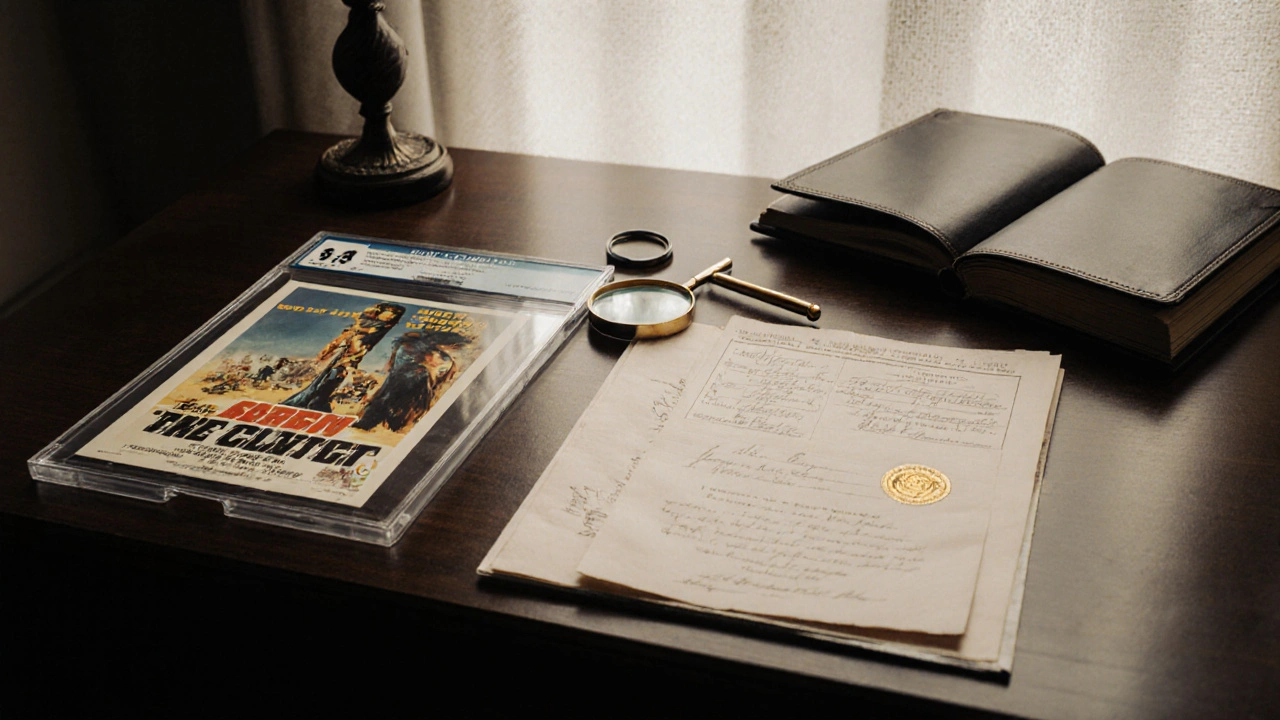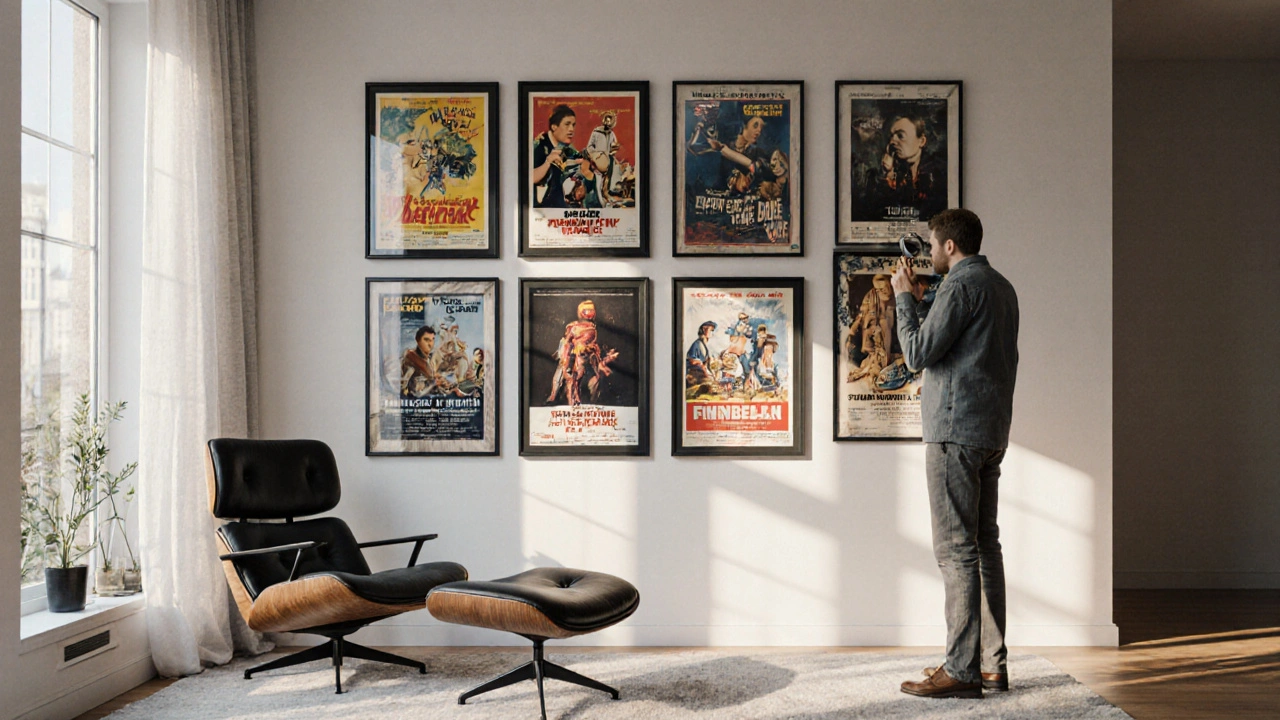Movie Poster Value Estimator
Estimate Your Poster's Value
Enter the details of your movie poster to get a professional estimate based on market trends.
When it comes to putting cash into something that looks great on a wall, movie posters are a surprisingly solid entry point. But not every glossy print will fetch a payday. Below is a no‑fluff, step‑by‑step rundown of how you can spot the posters that actually appreciate in value and avoid the cheap knock‑offs that sit in a drawer forever.
What Makes a Poster Valuable?
Every collector starts with the same three questions: Who made it? When was it produced? How rare is it? Answering those questions lets you rank any poster on a simple three‑point scale - origin, rarity, condition. If a poster ticks all three boxes, it’s likely to command serious money.
- Origin: Original artwork, a screen‑used print, or a poster signed by the artist or cast.
- Rarity: Limited runs (often < 500 copies), promotional variants, or region‑specific editions.
- Condition: No folds, tears, or color fading. Graded posters (A‑, B‑, etc.) sell for noticeably higher prices.
When you can verify all three, you’ve essentially got a collectible that behaves like a small‑scale investment.
Top Poster Types That Usually Fetch High Prices
Below is a quick snapshot of the categories you’ll see at auction houses and high‑end dealers. Use the table to gauge where your interest lies.
| Poster Type | Typical Price Range (USD) | Notable Example | Best Buying Source |
|---|---|---|---|
| Original One‑Sheet (pre‑release) | $2,000 - $15,000 | "Pulp Fiction" 1994 original art | Specialist auction houses (e.g., Heritage Auctions) |
| Artist‑Signed Poster | $800 - $5,000 | "Star Wars: The Empire Strikes Back" signed by JohnBarrowman | Verified dealer networks |
| Screen‑Used Print | $1,200 - $9,000 | "The Godfather" original set‑piece print | Estate sales, museum archives |
| Limited‑Edition Lithograph | $500 - $3,500 | "Blade Runner" 30‑year anniversary lithograph | Studio official stores, licensed online retailers |
| Prop‑Replica Poster | $400 - $2,200 | "Jurassic Park" dinosaur‑scene replica | Movie‑memorabilia conventions |
How to Verify Authenticity
Even the flashiest print can be a fake if you don’t do a quick check. Here’s a 5‑step verification routine you can run in under ten minutes:
- Check the paper stock - genuine 1970s‑80s posters often used 100‑200gsm matte stock.
- Look for printer’s marks - a small registration number or studio logo hidden in a corner.
- Compare the colors with a reference image from a trusted source (e.g., the movie’s official press kit).
- Ask for provenance - a scanned invoice, auction receipt, or a letter from the original owner adds credibility.
- Consider a third‑party grading service like PGS (Poster Grading Society) that can issue a condition report.
These steps cut the risk of overpaying for a reproduction dramatically.
Where to Buy Valuable Posters
Finding a treasure isn’t about hitting the first online marketplace you see. Quality sources include:
- Auction houses: Heritage Auctions, Bonhams, and Sotheby’s host dedicated film‑memorabilia sessions.
- Specialist dealers: Companies like Posteritati in NewYork have curated catalogs and authentication guarantees.
- Film‑convention stalls: Major events like Comic‑Con or the Cannes Film Market feature vetted vendors.
- Studio archives: Some studios sell limited‑edition runs directly via their official stores (e.g., Warner Bros. Gallery).
When you buy, always request high‑resolution photos, a certificate of authenticity, and the seller’s return policy.
Pricing and Selling Your Posters
Once you own a poster that meets the origin‑rarity‑condition test, the next step is setting a price. Two tools make this painless:
- Online price guides - sites like PosterPriceGuide.com aggregate recent sale data and provide a median value.
- Auction estimate calculators - many auction houses let you enter details (year, edition size, condition) for a free estimate.
When listing, include:
- A clear, well‑lit photo of the front and back.
- All provenance documents (certificates, receipts).
- Exact measurements - height x width in inches.
- Condition grading (A‑, B‑, etc.) with a brief description of any flaws.
Listing on niche platforms like eBay’s “Collectibles” category or on specialist sites such as Posteritati Marketplace often yields better returns than general‑purpose marketplaces.

Common Pitfalls to Avoid
Even seasoned collectors slip up. Here are the most frequent mistakes and how to dodge them:
- Chasing hype - A sudden surge in popularity (e.g., a meme‑driven revival) can inflate prices temporarily. Verify if the surge reflects genuine rarity.
- Ignoring condition - A poster with a tiny crease can lose 30‑40% of its value. Never overlook professional grading.
- Buying without provenance - A beautiful print with no paper trail is a gamble. Always demand documentation.
- Overpaying for “limited edition” labels - Some studios print thousands of “limited” runs. Check the actual print run number before committing.
Quick Checklist Before You Purchase
- Is the poster an original one‑sheet, artist‑signed, screen‑used, limited‑edition lithograph, or prop‑replica?
- Can you verify the print run size (usually listed on the back or in the seller’s description)?
- Do you have a clear, high‑resolution image showing edges and any marks?
- Is there documented provenance or a grading report?
- Does the asking price fall within the typical range shown in the table above?
If you can answer “yes” to all five, you’re probably looking at a poster that’s worth both on the wall and in your wallet.
Frequently Asked Questions
How do I know if a poster is a true limited‑edition?
Legitimate limited‑editions list the total number of prints on the back or in the accompanying certificate. Look for phrasing such as “Limited to 300 copies” and cross‑check with the publisher’s official announcement.
Are movie posters a good long‑term investment?
They can be, especially if you focus on original artwork, rarity, and condition. Prices for iconic titles like "Star Wars" or "The Godfather" have risen steadily over the past two decades, but like any collectible, market swings are possible.
What’s the safest way to store my posters?
Store them flat in a climate‑controlled environment, away from direct sunlight. Archival‑grade sleeves and acid‑free backing boards preserve both color and paper integrity for decades.
Do I need a grading service for every purchase?
Not necessarily, but a professional grade can boost resale value and buyer confidence, especially for high‑end items over $2,000.
Where can I find recent auction results for movie posters?
Auction house websites (Heritage, Bonhams, Sotheby’s) maintain searchable archives. Additionally, databases like ArtPrice and the PosterPriceGuide aggregate results across multiple platforms.


Alan Crierie
October 14, 2025 AT 14:30Great guide, thanks! 😊
Teja kumar Baliga
October 14, 2025 AT 15:53Thanks for the thorough write‑up! I especially appreciate the quick checklist you included.
Zach Beggs
October 14, 2025 AT 17:16I agree, the provenance tip is a lifesaver.
Kenny Stockman
October 14, 2025 AT 18:40Yo, always double‑check the paper stock; it saves you from a bad buy.
Ben De Keersmaecker
October 14, 2025 AT 20:03Your three‑point scale-origin, rarity, condition-provides a clear framework for evaluation.
Aaron Elliott
October 14, 2025 AT 21:26While the article is comprehensive, it glosses over the volatility inherent in niche collectibles markets. Investors should remember that trends can shift dramatically, especially when a film experiences a resurgence due to streaming platforms.
Chris Heffron
October 14, 2025 AT 22:50Indeed, market swings can be dramatic 🙂.
Adrienne Temple
October 15, 2025 AT 00:13If you need help reading the printer’s marks, just ask!
Sandy Dog
October 15, 2025 AT 01:36I was absolutely thrilled when I first lay eyes on that pristine 1978 Blade Runner lithograph, trembling with the knowledge that such a piece could exist. The glossy sheen of the paper seemed to capture the neon rain of the film itself. Yet, the journey to verify its authenticity felt like a quest through a labyrinth of archives. I dusted off my old catalogues, cross‑referencing each tiny registration number. Then I called a dealer who swore on a stack of certificates that the piece was truly limited‑edition. The dealer’s voice quivered with excitement as he described the original print run of just 350 copies. I imagined the original artist, hunched over a drafting table, hand‑picking each sheet. When I finally held the poster, the colors were still as vivid as the first day they left the press. No creases marred the surface, no fading dulled the iconic skyline. I felt a surge of pride, knowing I owned a fragment of cinematic history. But the real triumph came when the auction house listed it and the bidding wars erupted. Collectors from across the globe vied for it, their bids climbing higher with each passing minute. When the final hammer fell, the price exceeded my wildest expectations. That moment taught me that patience, diligence, and a love for the medium can turn a hobby into a rewarding venture. It also reminded me that every poster has a story waiting to be uncovered. So, fellow enthusiasts, never underestimate the thrill of chasing that perfect piece!
Nick Rios
October 15, 2025 AT 03:00Your point about climate‑controlled storage is spot on.
Amanda Harkins
October 15, 2025 AT 04:23Sounds solid, thanks.
Jeanie Watson
October 15, 2025 AT 05:46Good rundown, will keep these tips in mind.
Tom Mikota
October 15, 2025 AT 07:10Wow-so helpful??
Mark Tipton
October 15, 2025 AT 08:33It is increasingly evident that the ostensibly transparent auction houses are, in fact, orchestrating price inflation through coordinated bidding rings. These clandestine groups procure undervalued posters, artificially drive up the final hammer price, and then disperse the inflated valuations across the secondary market. Such practices are facilitated by the limited disclosure requirements imposed upon dealers, allowing them to conceal the provenance of bulk acquisitions. Moreover, the emergence of algorithmic pricing tools, marketed as objective, merely codifies the biases of a select few influential collectors. When a high‑profile sale, such as the recent Pulp Fiction original sheet, reaches a headline‑making figure, it sets a precedent that reverberates throughout the niche. Consequently, novice buyers are enticed to overpay, believing that the market will continue its upward trajectory indefinitely. Historical data, however, demonstrates periodic corrections, often precipitated by sudden shifts in popular culture or the re‑evaluation of an artist’s oeuvre. Should a major streaming platform resurrect a forgotten film, the demand spikes temporarily, only to collapse once the novelty fades. In addition, legitimate scholars lament the erosion of rigorous authentication standards as profit motives eclipse scholarly rigor. The proliferation of “limited‑edition” labels, frequently attached to runs numbering in the thousands, further muddies the waters for discerning collectors. Regulatory oversight remains scant, leaving the market vulnerable to manipulation by those with sufficient capital and insider connections. A prudent collector, therefore, must conduct exhaustive due diligence, cross‑checking each claim against multiple independent sources. Engaging reputable grading societies, requesting original invoices, and maintaining a skeptical stance toward overly exuberant sales narratives are indispensable safeguards. Ultimately, the sustainability of the movie‑poster market hinges upon transparency, education, and a collective commitment to curbing speculative excess. Only then can genuine enthusiasts preserve the artistic and historical value of these iconic artifacts for future generations.